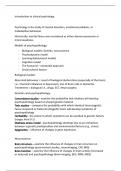Introduction to clinical psychology.
Psychology is the study of mental disorders, emotional problems, or
maladaptive behaviour.
Historically, mental illness was considered as either demon possession or
moral weakness.
Models of psychopathology:
- Biological models: Genetic, neuroscience
- Psychodynamic model
- Learning (behavioural model)
- Cognitive model
- The humanist – existential approach
- Social cultural factors
Biological models:
Abnormal behaviour = result of biological dysfunctions (especially of the brain)
i.e., chemical imbalance in depression, loss of brain cells in dementia.
Treatments = biological i.e., drugs, ECT, Neurosurgery.
Genetics and psychopathology:
Concordance studies - examine the probability that relatives will develop
psychopathology based on shared genetic material
Twin studies – compares the probability with which identical (monozygotic)
twins compared to fraternal (dizygotic) twins will develop symptoms of
psychopathology
Heritability - the extent to which symptoms can be ascribed to genetic factors
(ranges from 0-1)
Diathesis-stress model - psychopathology develops due to an interaction
between a genetic predisposition and environmental factors (e.g., stress)
Epigenetics – influence of changes in gene expression
Neuroscience:
Brain structure – examine the influence of changes in brain structure on
psychopathology (post-mortem studies, neuroimaging, CAT, MRI)
Brain function – examine the influence of changes in brain activity (increased
or reduced) and psychopathology (brain imaging, EEG, fMRI, MEG)
, Several brain structures have been implicated in psychopathology (e.g., frontal
lobes, amygdala, hippocampus)
Neurotransmitters – chemicals involved in communication between neurons,
increases and decreases in certain neurotransmitters have been linked to
psychopathology (e.g., low serotonin and depression, high dopamine and
schizophrenia)
Psychodynamic model:
Background: largely based on the work of Sigmund Freud
Assumption: abnormal behaviour = consequence of unconscious conflicts
(between ID, EGO and SUPEREGO) that developed during childhood
Treatments: Psychoanalysis: helping person to gain insight into these conflicts
in order to resolve them
ID= Drives (I want food, drink, sex etc.) EGO= intellect (If I am good, I’ll get…)
SUPEREGO= conscience (That beer belongs to my friend I shouldn’t drink it)
Defence mechanisms and developmental stages:
Defence mechanisms - in order to control the conflicts between the id, ego and
superego Freud suggested that individuals develop defence mechanisms (e.g.,
repression, regression, reaction formation)
Stages of development – Freud stressed the importance of how children
negotiated the stages of development
Fixation – if the child successfully negotiates each stage they develop normally,
but if they are unsuccessful, they can be fixated at a stage, which results in
psychopathology in adulthood (e.g., oral fixation participants will be obsessed
with putting things in their mouth, e.g., cigarettes, food)
Learning (behavioural) model:
Background: based on the work of the behaviourists (e.g., Watson, Skinner)
Assumption: Abnormal behaviour = consequence of maladaptive learning. “For
example: a woman who has developed a bird phobia”
Treatments: Behaviour Therapy: using remedial learning to modify abnormal
behaviour




